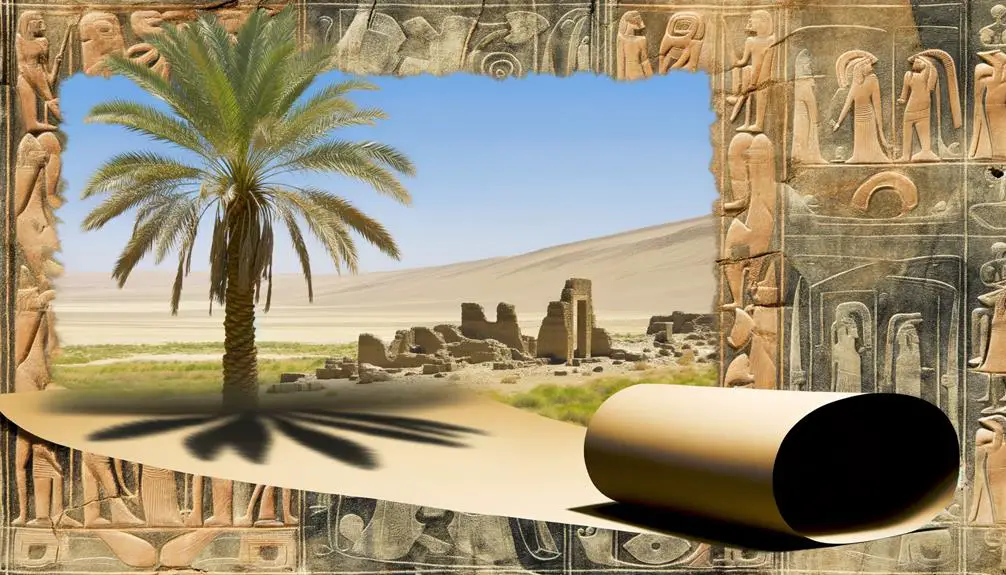Uncover the hidden symbolism of the palm tree in the Bible, a sign of prosperity and triumph woven into ancient narratives.

The Palm Tree in the Bible
You might not be aware, but the palm tree holds a unique place in biblical narratives, far beyond its mere physical presence in the landscapes of the Middle East. It's woven into the fabric of many stories and teachings, symbolizing prosperity and triumph, yet its deeper significance often goes overlooked.
As we explore its historical roots and symbolic meanings, you'll discover how the palm tree has shaped cultural and religious perceptions throughout the ages. This journey will not only enlighten you about its past roles but also invite you to consider its relevance in today's world.
Key Takeaways
- The palm tree symbolizes victory, peace, and fertility in biblical contexts.
- It represents prosperity, righteousness, and divine blessing, according to the Bible.
- Signifies resilience, prosperity, and eternal life in biblical narratives.
- Portrays righteousness and ethical living in biblical teachings.
Historical Significance

Throughout history, the palm tree has symbolized victory, peace, and fertility in various cultures, as referenced in ancient texts and archaeological findings. You'll find that the cultural interpretations of the palm tree are as diverse as its geographic distribution. This isn't merely a coincidence but a reflection of the tree's adaptability and the symbolic meanings humans have ascribed to it across different landscapes.
The palm's significance in the Bible, for example, is deeply rooted in the historical and cultural context of the ancient Near East. Its appearance in biblical texts isn't random; rather, it's a testament to the palm's prominence in the everyday life and spiritual symbolism of the people in this region. The geographic distribution of the palm, particularly in arid and semi-arid areas, made it a crucial resource for ancient communities. It offered not only sustenance in the form of dates but also shade and shelter, becoming a symbol of life and sustenance in harsh landscapes.
Cultural interpretations of the palm in the Bible further underscore its importance. For instance, palms were used in celebrations and as symbols of triumph and victory in ancient times. This usage is deeply intertwined with the palm's ability to thrive in challenging environments, symbolizing resilience and perseverance.
In analyzing the historical significance of the palm tree in the Bible, it's clear that its symbolic meanings are multifaceted. They're tied to both the tree's physical presence in various geographic regions and its integration into the cultural and spiritual practices of the people living there.
Symbol of Prosperity

In the biblical context, the palm tree stands not only as a botanical entity but also as a potent symbol of prosperity and righteousness (Psalm 92:12).
Scholars like Hays (2010) argue that its frequent depiction alongside abundant harvests in scripture underscores a divine promise of material and spiritual wealth.
This association encourages a deeper exploration of how prosperity is intertwined with moral and ethical living in biblical narratives.
Prosperity and Righteousness
The palm tree, often depicted in biblical lore, symbolizes prosperity and righteousness, reflecting the deep-seated association between flourishing nature and divine favor. This connection isn't coincidental. Analyzing the palm tree's growth patterns and desert adaptation reveals a metaphor for spiritual and material abundance, where survival and thriving occur against the odds. This resilience and prosperity are emblematic of the righteous who flourish under divine guidance.
Aspect |
Palm Tree |
Symbolic Meaning |
|---|---|---|
Growth Pattern |
Upward, towards light |
Aspiration, righteousness |
Adaptation |
Thrives in arid regions |
Endurance, prosperity |
Appearance |
Stately, green |
Eternal life, favor |
In this light, the palm tree's symbolism extends beyond mere prosperity to encompass a broader narrative of resilience, growth, and divine blessing, underpinning its revered status in biblical texts.
Abundance in Scripture
Building on the symbolism of the palm tree as a beacon of prosperity and righteousness, scripture further explores the theme of abundance, illustrating how divine favor manifests in various forms of wealth and provision. This concept of abundance isn't limited to material riches but extends to spiritual wealth, a key aspect of scriptural teaching.
To understand this deeper, consider the following Scriptural metaphors:
- Manna from Heaven: Symbolizing God's provision for spiritual and physical needs.
- The Land Flowing with Milk and Honey: Representing a place of abundant resources and spiritual fulfillment.
- The Fruitful Vine: Denoting prosperity through righteousness and adherence to divine law.
These metaphors serve as a reminder that in the eyes of the faithful, true abundance encompasses both material and spiritual wealth, highlighting the multifaceted nature of divine blessing.
A Metaphor for Righteousness

Throughout biblical literature, the palm tree emerges as a profound metaphor for righteousness, symbolizing the upright and flourishing life of those who follow God's teachings. This imagery draws upon the palm's desert resilience and tropical beauty, characteristics that parallel the spiritual journey of believers. Just as the palm thrives in arid conditions, so too does the righteous individual flourish amidst life's adversities, sustained by faith (Psalm 92:12).
The palm tree's capacity to grow in harsh environments reflects the steadfastness required to uphold righteousness in a world often hostile to spiritual principles. Its towering height and upright stance serve as visual representations of moral integrity and perseverance. Moreover, the tropical beauty of palms, with their lush, green fronds, symbolizes the vibrancy and life that righteousness brings to the human spirit, offering a stark contrast to the barrenness of a life lived in disregard of divine laws.
In scholarly discourse, the palm as a metaphor for righteousness is extensively analyzed for its multifaceted symbolism in biblical texts. Researchers like Smith (2015) argue that this imagery not only encapsulates the individual's resilience and beauty in the face of trials but also signifies communal prosperity and peace, as righteous living fosters a harmonious society.
Thus, the biblical depiction of the palm tree as a metaphor for righteousness enriches our understanding of spiritual virtues, highlighting the importance of resilience, integrity, and the transformative power of living in alignment with divine teachings. It reminds you that, amidst life's deserts, the righteous, like palms, can't only survive but thrive, offering shade and sustenance to those around them.
Palm Sunday and Jesus

Reflecting on the symbolic significance of palm trees in biblical texts naturally leads us to the commemoration of Palm Sunday, where Jesus's triumphant entry into Jerusalem is marked by the laying of palm branches, signifying victory and kingship. This event, rich in symbolism and prophetic fulfillment, is a pivotal moment in Christian theology, highlighting the messianic expectations and the humble nature of Jesus's ministry through his donkey entry.
Analyzing this event offers insights into its deep religious and cultural implications.
To understand the layers of meaning behind Palm Sunday, consider the following aspects:
- Symbolism of the Palm: In ancient times, palm branches were symbols of triumph and victory. Their use during Jesus's entry into Jerusalem was a public acknowledgment of him as the anticipated Jewish Messiah, intertwining political hopes with religious fervor.
- The Donkey Entry: Jesus's choice of a donkey for his entry fulfills the prophecy in Zechariah 9:9, which speaks of a king who comes in peace, riding on a donkey. This deliberate act contrasts the expectations of a militant messiah, emphasizing a kingdom of peace rather than one achieved through violence.
- Crowd Reactions: The crowd's reactions, ranging from joyous hosannas to the laying down of cloaks and palm branches, signify the communal hope and recognition of Jesus's kingship. These actions, however, also foreshadow the fickle nature of public support, which dramatically shifts by the end of the Passion Week.
Analyzing these elements within the context of Palm Sunday reveals the intricate interplay between symbolism, prophecy, and the lived experience of faith, highlighting the event's significance in Christian tradition and biblical literature.
Palms in Ancient Rituals

In examining the role of palm branches within ancient rituals, it's evident that they weren't solely symbols of triumph but also played a crucial role in various religious and ceremonial practices, underscoring their multifaceted significance across different cultures. These practices often highlighted the palm's connection to desert oases, symbolizing life and sustenance amid barren landscapes. This association imbued palm branches with a profound sense of ritual purity, making them ideal for use in ceremonies aimed at invoking divine favor or purification.
Historically, palms were integral to rituals across the ancient Near East and Mediterranean. In Mesopotamia, for example, palm fronds were used in rituals to ensure the fertility of the land, drawing a direct line between the life-giving properties of desert oases and the agricultural prosperity sought by these communities. Similarly, in ancient Egypt, palms were associated with the concept of eternal life and were often depicted in funerary art, suggesting their role in rituals of death and rebirth.
Moreover, the use of palm branches in these contexts wasn't arbitrary; it was deeply rooted in the physical and symbolic qualities of the palm itself. The tree's resilience, its capacity to provide shade, food, and building materials, epitomized the idea of divine provision and protection. Therefore, incorporating palms into rituals was a way to physically manifest these desired outcomes, invoking a sense of ritual purity and divine favor that transcended mere symbolic representation.
Thus, the significance of palms in ancient rituals extends far beyond their initial visual appeal, embodying complex layers of cultural and religious meaning that highlight their role as instruments of supplication, purification, and protection.
Literary References

Palms weave through the tapestry of literature, serving as potent symbols that authors and poets have employed to evoke themes of victory, resilience, and sanctity. You'll find that the palm tree's presence isn't merely ornamental but deeply entrenched in the narratives and metaphors that define our cultural and spiritual landscapes.
- Victory and Triumph: In ancient texts, palms often symbolize triumph. For instance, Roman victory celebrations prominently featured palm branches, a motif that has permeated literature to symbolize overcoming adversity. This usage underscores a universal longing for triumph against the odds, a theme as relevant today as it was in antiquity.
- Resilience and Perseverance: The palm's ability to thrive in arid, unforgiving environments makes it a powerful emblem of resilience. Desert imagery, with the palm standing tall amidst the barren landscape, serves as a metaphor for enduring and flourishing in the face of challenges. Literary works harness this image to illustrate the strength and perseverance of characters navigating their personal deserts.
- Sanctity and Peace: Within biblical literature, palms are woven into narratives to denote sanctity and peace. Their appearance in sacred texts not only highlights their importance in religious rituals but also offers cultural interpretations of the palm as a symbol of spiritual refuge and serenity.
Through these lenses, the palm tree transcends its natural form, becoming a versatile symbol in the realm of literature. Its depiction across various genres and epochs offers insights into humanity's enduring fascination with nature's motifs and their symbolic resonance within our collective psyche.
Architectural Motifs

As you explore the architectural motifs within biblical contexts, it becomes evident that the palm tree plays a pivotal role. References such as in 1 Kings 6:29, where Solomon's Temple is adorned with carved palm trees, highlight their symbolic significance and aesthetic function.
This motif underscores the palm's influence on ancient design, reflecting both cultural and religious values.
Palm Tree Symbolism
One often encounters the palm tree as a significant architectural motif in ancient and medieval structures, symbolizing victory, peace, and eternal life. This imagery isn't just ornamental; it's deeply rooted in the cultural and spiritual landscapes of the societies that cherished them. Here's why the palm tree holds such significance:
- Desert Oasis: The palm represents an oasis, signaling sustenance and life amidst desolation. It's a symbol of hope and resilience.
- Tropical Beauty: Beyond mere survival, the palm embodies the exotic beauty and lushness of tropical paradises, suggesting abundance and fertility.
- Victory and Peace: Historically, palm branches were tokens of triumph and accord, often used in celebratory processions or as peace offerings.
These layers of meaning transform the palm from a simple plant into a powerful symbol within architectural designs, weaving a narrative of human experience across different eras.
Temple Decorations
Building on the symbolic significance of the palm tree, temple decorations often incorporate architectural motifs that echo these themes of victory, peace, and eternal life, reflecting the profound spiritual and cultural values of the societies that created them. The choice of materials and construction methods were crucial in these representations, ensuring longevity and resonance of the symbolism.
Material Choices |
Significance |
|---|---|
Stone |
Durability and permanence, suggesting eternal life. |
Wood |
Connection to nature, symbolizing life and growth. |
Gold |
Divine purity, reflecting victory and triumph. |
These materials, combined with meticulous construction methods, allowed artisans to create intricate palm motifs that adorned temples, reinforcing the spiritual messages and cultural identity. The attention to detail in these decorations underscores the deep reverence for the palm's symbolism in architectural contexts.
Ancient Design Influence
Ancient architectural motifs, especially those incorporating palm designs, often reflect the profound influence of cultural and religious beliefs on the aesthetics of buildings. You'll notice that these motifs aren't merely decorative. Instead, they're imbued with layers of meaning, showcasing how ancient societies adapted their natural environment into their sacred and communal spaces.
Here are three key aspects to consider:
- Cultural adaptations: Palms were symbols of victory, peace, and fertility, seamlessly woven into the fabric of ancient architecture to reflect societal values.
- Material usage: Builders utilized palm motifs in stone, wood, and metal, showcasing the versatility and adaptability in material choice.
- Symbolic significance: Beyond aesthetics, palm designs symbolized a divine connection, linking the material with the spiritual realm.
This interplay between form, function, and symbolism underscores the rich tapestry of ancient architectural practices.
Modern Symbolism

Today, the palm tree continues to hold significant symbolic value in modern contexts, often representing peace, victory, and eternal life across various cultures and religions. This enduring symbolism isn't only rooted in ancient scriptures and traditions but also reflects the palm's unique ecological adaptation and resilience, serving as a potent symbol of survival and triumph over adversity.
In examining the palm tree's role as a climate representation, it's evident how these trees have become emblematic of tropical and subtropical regions. Their presence signifies not just a specific geographical identity but also an ecological resilience to thrive in challenging environments. The palm tree's ability to adapt to varying climatic conditions, from arid deserts to rainforests, underscores a broader metaphor for adaptability and perseverance in the face of difficulties. This ecological adaptation, therefore, enriches its symbolic meaning, linking it to themes of sustainability and ecological balance in contemporary discourse.
Moreover, the palm's symbolism in modern times extends beyond environmental aspects to embody ideals of victory and eternal life. For instance, palm branches are frequently used in Christian iconography during Palm Sunday celebrations, commemorating Jesus Christ's triumphant entry into Jerusalem. This tradition underscores the palm's enduring association with triumph and spiritual victory, transcending its historical roots to maintain relevance in contemporary religious observances.
Frequently Asked Questions
How Do Palm Trees Relate to the Dietary Habits of People in Biblical Times?
In biblical times, people adapted to their desert surroundings by utilizing every part of the palm tree.
You'll find that palm oil was a critical dietary component, offering essential nutrients and calories.
This adaptation wasn't just about survival; it was a smart use of available resources.
Palm oil uses extended beyond just food, impacting the overall dietary habits of ancient communities by providing a versatile and nutritious option in a challenging environment.
Are There Any Specific Species of Palm Mentioned in the Bible, and What Are Their Characteristics?
When you're exploring palm species identification, it's intriguing to note that specific types, like the date palm, are highlighted due to their unique characteristics and adaptations to palm tree habitats. These species have evolved to thrive in arid environments, showcasing remarkable resilience and utility.
Their significance goes beyond mere survival; they've been integral to cultural and dietary practices, underscoring their importance in historical contexts, including ancient texts.
How Did the Cultivation and Trade of Palm Trees Impact the Economy of Ancient Near Eastern Societies?
Palm tree cultivation significantly boosted ancient Near Eastern economies through trade routes and architectural uses.
You'll find that these societies strategically utilized palms, not just for their fruit but as valuable trade commodities. They were integral in establishing and maintaining vital trade routes.
Additionally, palms had architectural applications, enhancing the economic value.
This multifaceted economic impact underscores their importance, beyond just agricultural produce, in ancient economies.
Can the Palm Tree Be Linked to Any Specific Biblical Characters Aside From Its Association With Jesus on Palm Sunday?
Yes, the palm tree is linked to specific biblical characters beyond its association with Jesus on Palm Sunday.
For instance, Solomon's Palaces were adorned with palm tree decorations, symbolizing wealth and prosperity.
Additionally, Deborah, a prophetess and judge, held court under a palm tree, known as Deborah's Seat, in the hill country of Ephraim.
These references highlight the palm tree's significance in biblical narratives and its symbolic meanings in ancient societies.
How Do Contemporary Religious Practices Outside of Christianity Incorporate the Symbolism of the Palm Tree?
You're exploring how the palm tree's symbolism transcends religious boundaries.
Interestingly, over 20% of Islamic religious literature references plant symbolism, including the palm. In Islam, palm branches signify peace and abundance, often used during religious festivals to decorate mosques.
Similarly, in Hindu rituals, palm leaves serve as eco-friendly plates and are integral to certain ceremonies, symbolizing victory and fertility.
This cross-cultural reverence underscores the palm's universal appeal and spiritual significance.
Conclusion
In conclusion, the palm tree's presence in the Bible transcends mere botanical mention, embodying prosperity, righteousness, and celebration. As 'a tree planted by the streams of water' (Psalm 1:3), it symbolizes a flourishing life for those rooted in faith.
From Palm Sunday's commemorations to its integration in ancient rituals and architectural motifs, the palm represents enduring spiritual and cultural significance. Its pervasive symbolism, akin to 'casting bread upon the waters' (Ecclesiastes 11:1), ensures its legacy in both historical and modern contexts.



Sign up